
Pole Position is a racing arcade video game released by Namco in 1982. It was licensed to Atari, Inc. for US manufacture and distribution. Pole Position is considered one of the most important titles from the golden age of arcade video games. It was an evolution of Namco's earlier arcade racing electro-mechanical games, notably F-1 (1976), whose designer Sho Osugi worked on Pole Position.
Racing games are a video game genre in which the player participates in a racing competition. They may be based on anything from real-world racing leagues to fantastical settings. They are distributed along a spectrum between more realistic racing simulations and more fantastical arcade-style racing games. Kart racing games emerged in the 1990s as a popular sub-genre of the latter. Racing games may also fall under the category of sports video games.

F-Zero GX is a 2003 racing video game developed by Amusement Vision and published by Nintendo for the GameCube console. It runs on an enhanced version of the engine used in Super Monkey Ball. F-Zero AX, the arcade counterpart of GX, uses the Triforce arcade system board conceived from a business alliance between Nintendo, Namco and Sega. Published by Sega, it was released alongside GX in 2003.
The Initial D video game series, known in Japan as Initial D Arcade Stage, is an arcade racing game series developed by Sega, based on the anime and manga series Initial D. In the United States and Europe, the game series is simply known as Initial D.

Daytona USA is a 1994 arcade racing game developed by Sega AM2. Inspired by the popularity of the NASCAR motor racing series in the US, the game has players race stock cars on one of three courses. It was the first game to be released on the Sega Model 2 arcade system board. Released by Sega in March 1994, Daytona USA is one of the highest-grossing arcade games of all time.
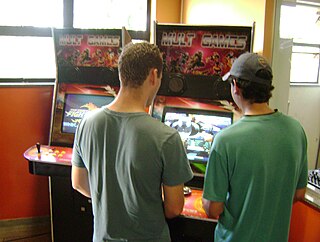
An arcade cabinet, also known as an arcade machine or a coin-op cabinet or coin-op machine, is the housing within which an arcade game's electronic hardware resides. Most cabinets designed since the mid-1980s conform to the Japanese Amusement Machine Manufacturers Association (JAMMA) wiring standard. Some include additional connectors for features not included in the standard.

Virtua Racing or V.R. for short, is a Formula One racing video game developed by Sega AM2 and released for arcades in 1992. Virtua Racing was initially a proof-of-concept application for exercising a new 3D graphics platform under development, the "Model 1". The results were so encouraging that Virtua Racing was fully developed into a standalone arcade title.
The following article is a broad timeline of arcade video games.
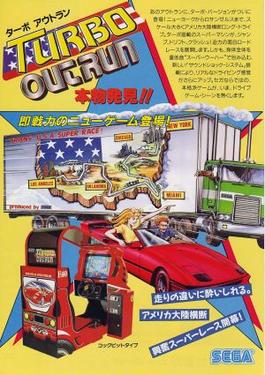
Turbo OutRun (ターボアウトラン) is a 1989 arcade racing game released by Sega. A follow-up to 1986's Out Run, it was released as a dedicated game, as well as an upgrade kit for the original Out Run board.

Hang-On is an arcade racing game released by Sega in 1985 and later ported to the Master System. In the game, the player controls a motorcycle against time and other computer-controlled bikes. It was one of the first arcade games to use 16-bit graphics and uses the Super Scaler arcade system board, created with design input from Yu Suzuki, as technology to simulate 3D effects. The deluxe cabinet version also introduced a motion-controlled arcade cabinet, where the player's body movement on a large motorbike-shaped cabinet corresponds with the player character's movements on screen.
Mario Kart Arcade GP is a sub-series of arcade games in Nintendo's Mario Kart series developed specifically for arcades in collaboration with Namco. To date, four entries have been released—Mario Kart Arcade GP (2005), Mario Kart Arcade GP 2 (2007), Mario Kart Arcade GP DX (2013), and Mario Kart Arcade GP VR (2017). The first three entries are considered to be relatively rare outside of Japan, with the fourth title not seeing a release outside of Japan at all. The games have been generally been well-received by critics, who have praised the game's transition of traditional Mario Kart gameplay into an arcade game format, while lamenting that none of the entries have been released outside of the arcade format onto any of Nintendo's home video game consoles.
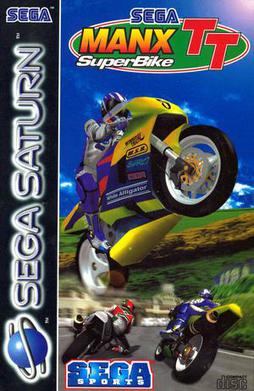
Manx TT Super Bike is a 1995 arcade racing game developed jointly by Sega AM3 and Sega-AM4. It is a motorcycle racing game built for the Sega Model 2 arcade board. Up to 8 players can race in this game if enough arcade cabinets are linked together, following on from Daytona USA. It was later ported to the Sega Saturn by Tantalus Interactive and to Windows by Perfect Entertainment.

Scud Race, known as Sega Super GT in North America, is an arcade racing video game released by Sega in 1996. It is the first racing game to use the Sega Model 3 hardware. Despite being released well within the lifetime of the Sega Saturn, no Saturn port was ever announced. A Dreamcast port was announced for the system's 1998 launch lineup and was shown as a tech-demo in the Dreamcast Presentation in 1998, but was cancelled.

Ace Driver is a 1994 racing arcade game developed and published by Namco. The player controls a Formula One racer, with the objective being to complete three laps of a race course and to avoid a collision with opponents and other obstacles. Three difficulty levels are available, as is a mode to enable a gear shift. Similar to Namco's own Final Lap series, the arcade cabinet can be linked together with another unit to enable eight-person multiplayer. It ran on the Namco System 22 arcade hardware.
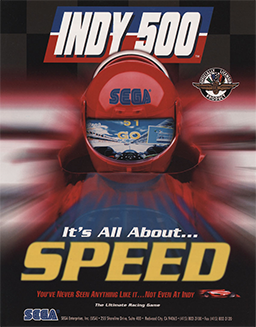
Indy 500 is a 1995 arcade racing game developed by Sega AM1. Based on the IndyCar Series, the game possesses a license from the Indianapolis Motor Speedway, home of the Indianapolis 500, and includes the speedway as one of its courses. Indy 500 was AM1's second game developed using 3D computer graphics and their first to utilize color textures. While planned as a Model 3 arcade system board release, delays in the hardware's completion led to use of the Model 2 instead. A Sega Saturn port was planned, but later canceled. Reception to Indy 500 was mixed, with some critical comparison to other games such as Sega AM2's Daytona USA and Namco's Ace Driver and Rave Racer.

Super Monaco GP is a Formula One racing simulation video game released by Sega, originally as a Sega X Board arcade game in 1989, followed by ports for multiple video game consoles and home computers in the early 1990s. It is the sequel to the 1979 arcade game Monaco GP. The arcade game consists of one race, the Monaco Grand Prix, but later ports added more courses and game modes based on the 1989 Formula One World Championship.

Motor Raid (モーターレイド) is a racing video game released by Sega on its Model 2A arcade system board in 1997. In contrast to the realistic style of most of Sega's previous racing games, Motor Raid uses a futuristic aesthetic and gameplay supplemented by fighting elements.

Sega Rally 3 is the arcade sequel to Sega Rally 2, developed and released by Sega in 2008. Unlike most other installments in the series, this was not released in Japan. Home version was released for the Xbox 360 and PlayStation 3 in 2011 as Sega Rally Online Arcade.

Road Race is a 1976 car driving arcade racing video game developed and released by Sega in February 1976. Later the same year, Sega released two motorbike racing variants, Man T.T. and Moto-Cross, which were in turn re-branded as Fonz, in November 1976. The game was based on the character Fonzie from the 1970s TV show Happy Days, with the slogan being "TV's hottest name, Your hottest game". Sega licensed Fonz because at the time it was owned by Charles Bluhdorn's Gulf+Western Company and it was a Paramount Television intellectual property.
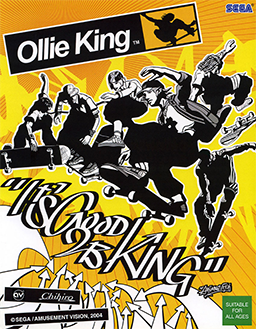
Ollie King is an arcade skateboard racing game developed by Amusement Vision and published by Sega for the Xbox based Sega Chihiro hardware in March 2004 making it the only Amusement Vision game not to run on Sega or Nintendo based hardware. following limited location tests in late 2003. The game was revealed at Tokyo's JAMMA Arcade Show in 2003. A spiritual successor to Top Skater, it was created by the same team that developed Jet Set Radio.
















